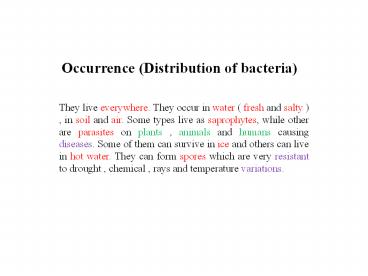Occurrence (Distribution of bacteria) - PowerPoint PPT Presentation
Title:
Occurrence (Distribution of bacteria)
Description:
... Some of them have pin-head thickenings and they give an impression of branched structure and they causes diseases in ... Actinomycetes (Filamentous/Mold ... – PowerPoint PPT presentation
Number of Views:102
Avg rating:3.0/5.0
Title: Occurrence (Distribution of bacteria)
1
Occurrence (Distribution of bacteria)
- They live everywhere. They occur in water ( fresh
and salty ) , in soil and air. Some types live as
saprophytes, while other are parasites on plants
, animals and humans causing diseases. Some of
them can survive in ice and others can live in
hot water. They can form spores which are very
resistant to drought , chemical , rays and
temperature variations.
2
Morphology of Bacterial cell
- Eubacteria have three main shape categories (Fig.
2) - Rod-shaped eubacteria are known as bacilli. These
are short rods - According to their arrangement , they are
divided to - MonoBacilli Some of them have pin-head
thickenings and they give an impression of
branched structure and they causes diseases in
human - Diplobacilli They occur in pairs, also causing
diseases in humans - Streptobacilli. That occur in chains of different
lengths - 2. Spherical eubacteria are called cocci They
are divided in six groups depending on the cell
arrangement and cell division - Micrococci. They are single celled and lives as
saprophytes - Diplococci. The cell divides in one plane and the
pairs remain attached - Streptococci. Division of cell in one plane and
causes diseases in humans - Tetracocci. The cell divides in two planes
resulting in four cells and causes diseases in
humans - Sarcinae. The cell divides in three planes
resulting in 8 cells - Staphylococci. Division in several planes
resulting in cluster of cells
3
- 3. Spiral are called spirilla
- They can be divided into
- Vibrion. The cell resemble a comma in appearance
- Spirillia. Coiled forms exhibiting twists with
one or more turns. They have constant shapes and
they move by flagella - Spirochaets. They are intermediate between
bacteria and protozoa, they dont have cell wall
and flagella. Their movement is like a worm
4
- 4. Actinomycetes (Filamentous/Mold-like
bacteria) - Their body consists of mycelium just like fungi.
Streptomyces group belongs to these mold like
bacteria. Streptomycin, an antibiotic is produced
by Streptomyces.
5
Motility in bacteria
- Bacteria are either nonmotile or motile. Motile
forms are either creeping or swimming. Creeping
bacteria (e.g. Myobacterium) move or creep slowly
on a supporting surface as a result of wave-like
contractions ( contract and relax) of their
bodies. Swimming bacteria move freely in a liquid
medium due to the presence of flagella.
Flagellated forms differ with respect to number
and pattern of attachment of flagella. The
following forms (Fig .3) can be given - Monotrichous. One flagellum attached to one pole
of the cell. - Lophotrichous. A tuft of flagella at one pole of
the cell. - Amphitrichous. A single or a tuft of flagella at
the two poles of the cell. - Peritrichous. Many flagella distributed over the
whole surface of the cell.
6
Fig. 3. Motility of bacteria
Monotrichous
Lophotrichuos
Amphitrichous
Peritrichous































